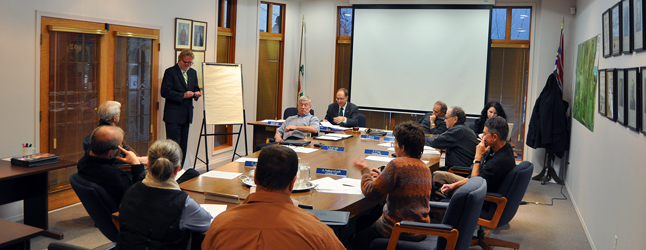
By David F. Rooney
City Council has begun the long, arduous process of developing a rational and workable financial plan for the next five years.
Last year’s budget process was sometimes torturous and acrimonious and this new one could well prove to be the same. But Chief Administrative Officer Tim Palmer and Finance Director Graham Inglis began by taking Mayor David Raven and members of Council, including Councillors-elect Linda Jean Nixon and Gary Starling, a few steps down the budget path by discussing some of the issues and problems they’ll encounter over the next six months.
In their executive overview, the City’s two top civil servants discussed the main features of the budget process, tax increases, debt and borrowing, the problem of infrastructure debt, statistical manipulation, budget creep and the demand for more services and an executive summary of a preliminary draft of the 2012-2016 Financial Plan that could see property taxes increase by 2.23% next year and by 2% in each of the following four years. That’s less than the rate of inflation which is currently 2.9%. (Click here to read the preliminary version of the plan.)
Starting in December after their inauguration on December 5, Mayor Raven and Councillors Chris Johnston, Tony Scarcella, Phil Welock, Steve Bender, Linda Jean Nixon and Gary Starling will begin grappling with these weighty financial matters.
With the full knowledge that statistics can be manipulated by special interest groups and even municipal staff, they’ll have to determine how to manage budget cuts while maintaining the services Revelstokians have come to expect and even demand. They won’t do this in a political vacuum, either, as public review and participation is part of the budget process.
“If you raise taxes there’s grumbling, of course there is, but if you cut a service — say pool times — there’s practically an armed revolt,” observed Steve Bender.
“People want to have their cake and eat it, too,” said Chris Johnston.
Both of those observations are true. The key to success is a kind of Goldilocks approach to budget cuts and tax increases — you want to balance them so they’re just right.
And then there’s the problem of infrastructure deficits.
“We’re worse off that we were a few years ago because we’re not putting money in infrastructure,” Palmer said. “I’ve been told we need to spend at least $20 million on roads alone and… we have no reserves for road replacement. Roads that are eroding now will soon just become gravel.”
He said road replacement and new fire hydrants will be major components of the new budget and he even suggested to Darren Komonoski, the Public Works Department’s operations manager, he should start planning for that but “oh, by the way, don’t increase the bottom line.”
That’s likely going to demand some truly creative thinking, something Johnston picked up on.
“Maybe I’m dreaming but we’ve been fixing things to a 1950s standard,” he said. “I wonder if we shouldn’t be looking at doing things a little differently.”
But as Phil Welock noticed, that could be difficult.
Many of the infrastructure problems facing the City today are the result of short cuts taken decades ago by builders and others. Think of the Big Eddy, there are water lines all over the place and no one knows where they are anymore.
“Street weren’t built properly; sidewalks weren’t built properly,” Welock said, adding that “when you lose the Sam Olynyks and Brian Yeomans and the other good City workers you lose that knowledge of what’s where.”
Another potential pitfall for City Council are all the requests for funding from local organizations and special interest groups as well as downloading by the province that shoves more responsibility — usually without any funding support — on municipal governments. If Councils take on those responsibilities they run the risk of finding themselves in the position of perpetually financing things that really aren’t their responsibility. And that — though it may be morally excellent — fattens up budgets and — inevitably — tax increases.
So… what kind of preliminary numbers are we looking at?
Where the City had an overall budget of $31.1 million last year, Inglis anticipates a sleeker budget at $28.29 million for 2012. Operating revenues are projected to be $17.6 million, up from $16.6 last year and general operating expenses are forecast to be $16.68 million, up from $16.55 million.
These are, as Inglis and Palmer stressed, preliminary numbers from a rudimentary draft plan. They are not carved in stone and, at this point, should not alarm anyone. Last year’s budget, proposed tax rates and the whole concept of public spending became the subjects of controversy early in the process with strong opinions expressed by many residents with different views.
The proposals will be discussed and reviewed by the City’s Finance Committee and Council in general.
For the newcomers to Council — Linda Jean Nixon and Gary Starling — this is clearly new territory and they recognize the learning curve ahead of them.
“We have a lot to learn about everything,” Nixon said. “One of them is what’s the role of Council.”
She found Tuesday’s session with Palmer and Inglis helpful, as did Starling. “It’s a lot to take in,” he said.
The spending targets and other proposals will also be the subjects of discussion as well as consideration by those members of the public and the business community who are to be invited to provide feedback to Council on the budget, as they did last year.
And, finally, beginning with the public review set to begin in January any member of the public can have his or her say on the proposed 2012-2016 Financial Plan.



